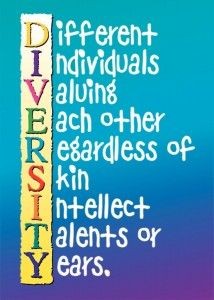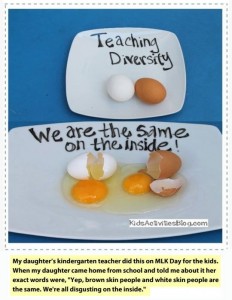Same Ol’e, Same Ol’e
September 14th, 2016
First, I think it is important we are on the same page as to what “diverse” and “social justice” mean, and what “diverse learners” are. “Diverse” means to be different from each other. “Diverse learners” are students who are different in some way, such as, ethnically, racially, linguistically, or culturally. “Social justice” is the belief in human equality and fairness.
 To me, a teacher who is effectively supporting diversity and social justice in the classroom is someone who is fully aware of the diverse learners she or he is educating. This teacher is also able to address the topic of diversity amongst the students in her or his classroom appropriately. Doing this would include the teacher being able to provide readings that promote diversity in her classroom in order to show that diversity is important in having a great learning experience. As a teacher, I would do this by using other examples such as having diverse meals. I would ask the students if they would want to eat the exact same meal every single day for the rest of their lives. Their answer being no, I would then ask them to make a list of the foods they love to eat. I would already have a list of foods of my own that I could describe where they came from. This list could be American foods that originated in other countries or cultures (pizza and spaghetti are Italian), or it could be different ethnic foods (Mexican and Chinese). With this introduction, I could then explain to students that spending time with people of different races, ethnicities, religions, cultures, etc. is just as important as having diverse meals.
To me, a teacher who is effectively supporting diversity and social justice in the classroom is someone who is fully aware of the diverse learners she or he is educating. This teacher is also able to address the topic of diversity amongst the students in her or his classroom appropriately. Doing this would include the teacher being able to provide readings that promote diversity in her classroom in order to show that diversity is important in having a great learning experience. As a teacher, I would do this by using other examples such as having diverse meals. I would ask the students if they would want to eat the exact same meal every single day for the rest of their lives. Their answer being no, I would then ask them to make a list of the foods they love to eat. I would already have a list of foods of my own that I could describe where they came from. This list could be American foods that originated in other countries or cultures (pizza and spaghetti are Italian), or it could be different ethnic foods (Mexican and Chinese). With this introduction, I could then explain to students that spending time with people of different races, ethnicities, religions, cultures, etc. is just as important as having diverse meals.  I would also talk about how these very different types of people will all have such different experiences and bring extremely interesting things to writing. I would go back to showing poems and excerpts and even songs written by diverse people and point out and discuss how different their lives could be from theirs and how it is incorporated into their writing. I would then have each student write a short piece about a life experience they have and pair up with someone to see how their lives differ or are the same. I could even show the movie Zootopia or just clips from it to show diversity issues. To bring out social justice, I would bring in news articles on what is going on in todays society with issues such as Black Lives Matter and whether or not to let refugees into the U.S. I would use topics that are extremely controversial and get students to speak up about what they think is fair and unfair. I would also use stories about Rosa Parks, Martin Luther King Jr., Hispanics in California, and any others I can find. Class discussions on this topic would be easy to start and guide down the road of everyone being kind to one another and treating each other fairly in attempt to avoid issues of social justice in their lives. I would show student’s that they have a responsibility to do everything they can to promote equality and fairness for everyone, and they can start in the classroom.
I would also talk about how these very different types of people will all have such different experiences and bring extremely interesting things to writing. I would go back to showing poems and excerpts and even songs written by diverse people and point out and discuss how different their lives could be from theirs and how it is incorporated into their writing. I would then have each student write a short piece about a life experience they have and pair up with someone to see how their lives differ or are the same. I could even show the movie Zootopia or just clips from it to show diversity issues. To bring out social justice, I would bring in news articles on what is going on in todays society with issues such as Black Lives Matter and whether or not to let refugees into the U.S. I would use topics that are extremely controversial and get students to speak up about what they think is fair and unfair. I would also use stories about Rosa Parks, Martin Luther King Jr., Hispanics in California, and any others I can find. Class discussions on this topic would be easy to start and guide down the road of everyone being kind to one another and treating each other fairly in attempt to avoid issues of social justice in their lives. I would show student’s that they have a responsibility to do everything they can to promote equality and fairness for everyone, and they can start in the classroom.
[youtube]https://youtu.be/l-gQLqv9f4o[/youtube]
A teacher can have a massive impact on students and how they view diversity and social justice, amongst many other important topics. It is a teacher’s responsibility to show students the need for diversity and how social justice makes it possible to have differences. I want to teach my students about the important of having differences and how they make us grow and give us perspective. Without differences, life would be boring. I also want to teach my students how social justice is what makes diversity possible. Making a stand to promote social justice in their lives is important for them to do now, so that they can do it as adults.
A teacher should also focus on diverse learners. Not only does their race, religion, culture, ethnicity affect how they learn, but can also be different linguistically. Everyone has a different dialect and we as teachers must be aware of this and show students that their dialect is right, but not always appropriate to use. We also often have students who speak entirely different languages and have to figure out how to adapt our lessons to accommodate their linguistic needs. This can be especially difficult, but teachers must be willing to enlist the help of others.”We need a range of strategies to cope with the different students and their challenges. We also need to remember that their challenges are more complicated than just the acquisition of a language” (Burke, 2012, p. 380). If I am ever in the situation to teach a student who speaks another language, I plan to implement practices such as speaking slowly, using gestures, giving directions with illustrations, giving them a partner that can show them what to do, and talking with ELL teachers for help (Burke, 2012, p. 380).
I want my classroom to be an extremely welcoming environment where students feel they can talk to me about anything and feel heard and important. I want students to all feel like they are equal in my classroom, no matter their class, race, culture, etc. All students deserve the opportunity to be heard and learn everything they can.
[youtube]https://youtu.be/RwlhUcSGqgs[/youtube]
All pictures are from: https://www.pinterest.com/search/pins/?q=diversity%20humor%20kids&rs=typed&term_meta[]=diversity%7Ctyped&term_meta[]=humor%7Ctyped&term_meta[]=kids%7Ctyped
Burke, J. (2008). The English Teacher’s Companion: A Complete Guide to Classroom, Curriculum, and the Profession, 3rd ed. Portsmouth, NH: Heinemann.
September 15th, 2016 at 7:36 pm
I love the idea of asking students if they would want to eat the same thing for the rest of their lives as an example of why diversity is a good thing! I can imagine some students sarcastically replying that they would totally eat pizza every day, but they would definitely get the point. I also like your comment about how a life without diversity would be boring. I think that’s something that you could easily prove to your students to get them to understand and except diversity.
September 16th, 2016 at 1:18 pm
I really love all of your ideas about trying to get students to understand why diversity is bad. Too often people think of differences as divisive, when they really should be celebrated, which your ideas will help bring to light. I think that incorporating poetry and music as a way to celebrate diversity is a wonderful idea. Much of the time, music and poetry portray universally applicable themes about the human experience, so perhaps seeing how the same themes are conveyed in various cultures will show students that they really are not so different after all. Not only will activities like culturally different poetry and music show diverse students that they have more in common than they think, it will also introduce them to the unique nuances that exist within the culture the author or composer is writing about.
September 16th, 2016 at 1:30 pm
Hi Gabrielle,
I just rediscovered the importance of proofreading comments before I post. My first sentence should actually read “I really love all of your ideas about trying to get students to understand why diversity isn’t bad.” I definitely did not mean to say that diversity is bad.
September 19th, 2016 at 1:47 pm
Starting with definitions is perfect. We use those terms but aren’t sure what we mean. I like the way you connect it all to yourself. Your use of visuals is very effective!